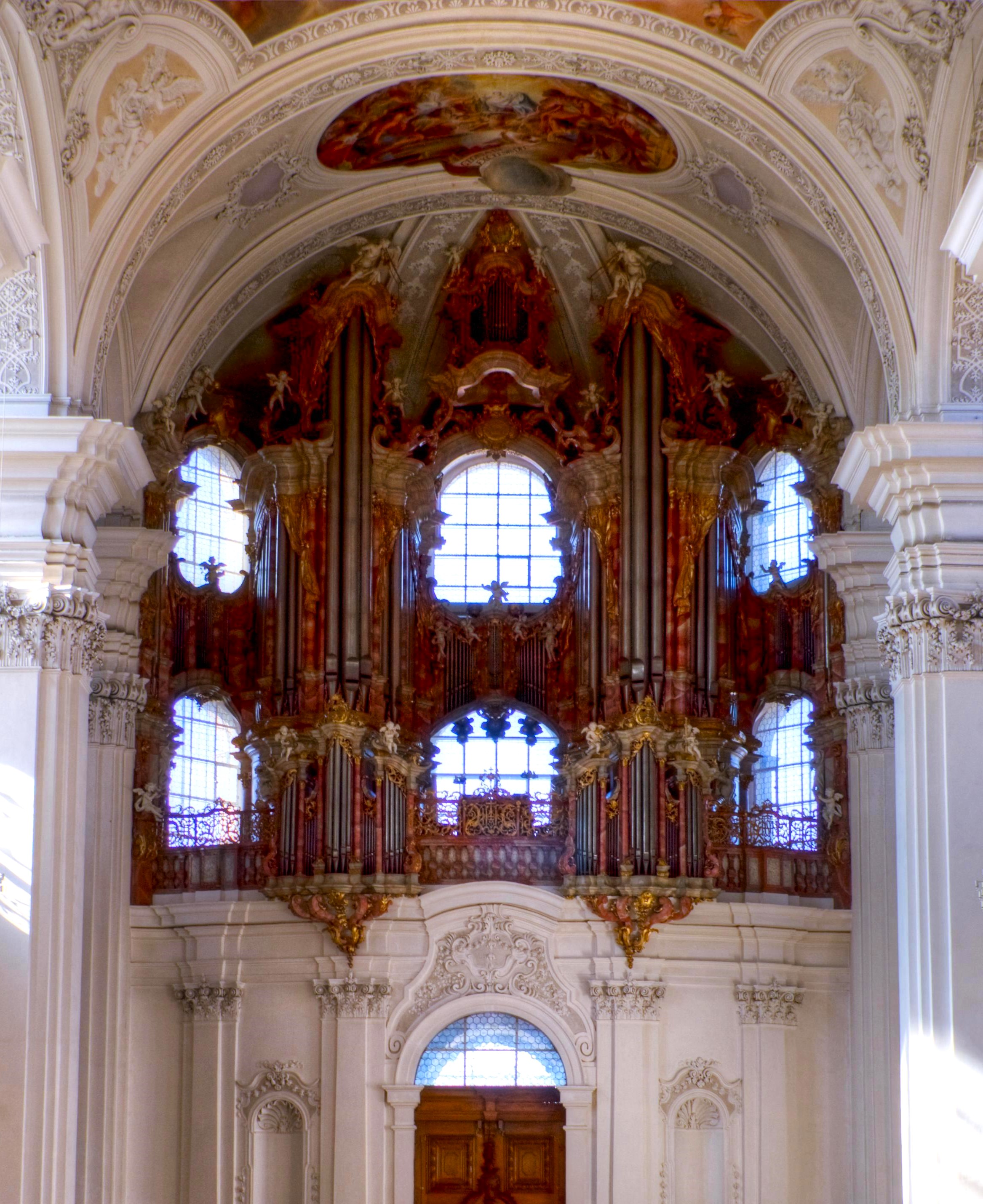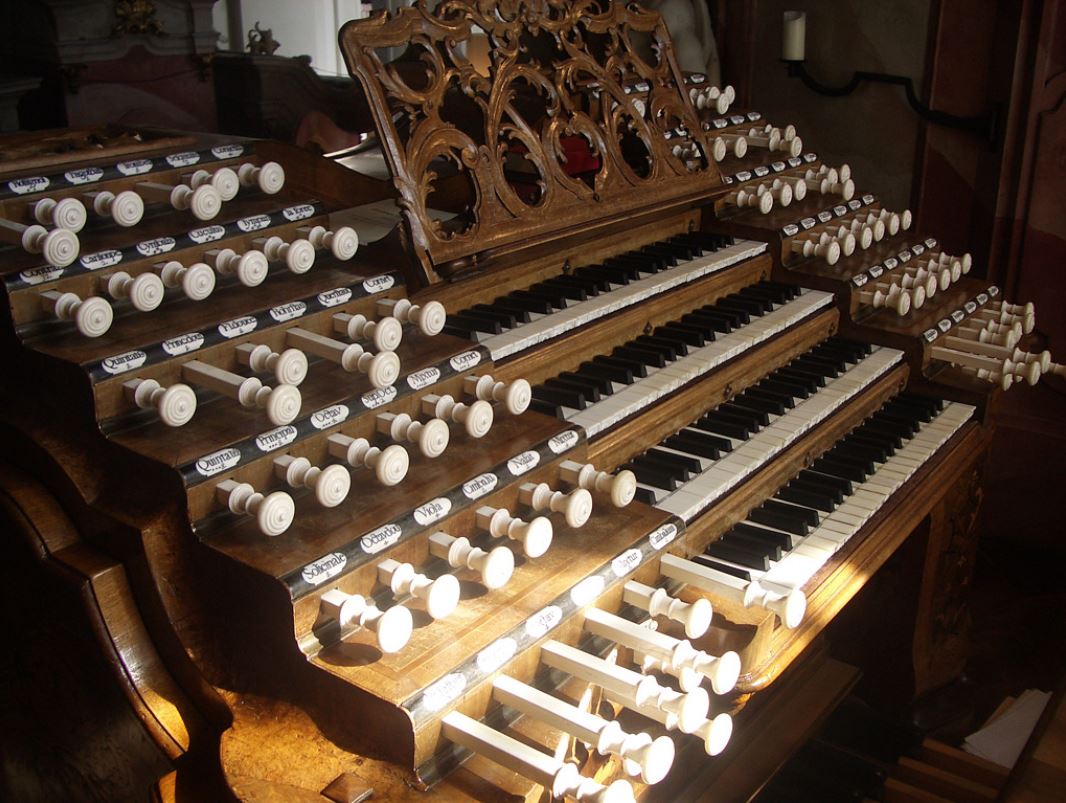Weingarten, Basilika St. Martin
| Builder | J. Gabler |
|---|---|
| Year | ca. 1750 |
| Period/Style | Baroque |
| Stops | 65 |
| Keyboards | 4+P |
| Keyaction | tracker/mechanical |
| Tuning | Modified Unequal Temperament |
The organ was constructed by Joseph Gabler in the years 1736-1750. Originally, an earlier organ was constructed by Martin Rück for the basilica in 1532, but it was destroyed in war in 1632. Several modifications were made to the organ in the 19th and 20th centuries. A few notable renovations include an overhaul by Maucher of Konstanz in 1811, a repair by Braun of Spaichingen in 1826, and a major renovation by Weigle, who also added Barker levers in 1878. In 1861, Weigle became responsible for the organ's maintenance.
Between 1908-1910, an electric blower was installed, a major renovation by Weigle. In 1912, the range of tones was expanded and a Hochdruckwerk (High-Pressure-Division) was erected on the side gallery according to Weigle's patented system.
Later, the Kronpositiv was connected with electric traction. In 1954, a general overhaul was carried out by Steinmeyer, where they modified the wind supply and extended the pedal range. The high-pressure work was replaced by a swellable accessory work with 7 registers, constructed by Reiser and Späth. In 1983, further restoration was done, and the additional work was removed.
The Great Organ in Weingarten carries with it numerous legends, such as the Vox Humana legend, rooted in the question of whether it's possible to imitate the human voice using an organ register (despite the name, Vox Humana registers in organs rarely achieve this). Legend has it that despite his efforts with special metal alloys, Gabler was unsuccessful until Satan whispered to him one night, offering assistance in exchange for his soul.
On a stormy night, Gabler allegedly sneaked out of the monastery and made his way to Laurastein to meet the Devil, who appeared to him as a hunter. Gabler supposedly signed away his soul with his blood as ink, and in return, received a metal for pipe casting. After casting the pipes with the metal provided by the Devil, the Vox Humana register allegedly sounded like a human voice, albeit producing secular music instead of sacred hymns, leading many monks to abandon their cells for worldly pleasures. Gabler was then apprehended by the Abbot and confessed to the "dark deed." He was then put on trial and was to be burnt in the monastery courtyard along with the mysterious register. However, he managed to create a replacement for the diabolical register, earning clemency.
Gabler, allegedly unpaid by the monks, requested the keys to the organ years after its completion under the pretext of making a minor adjustment. Inside the instrument, he flipped a single lever, causing the organ to emit only a faint moan. Alarmed, the Abbot and the convent gathered, and Gabler promised immediate relief if his overdue wages were paid. Upon payment, Gabler restored the organ to its former glory with a single movement. There was also an incident involving the lever in 1905, when the organ was suddenly unplayable. In 1912, during a renovation by organ builder Weigle, the hidden lever was reportedly discovered and removed, serving as a kind of throttle valve to control the wind supply. During the restoration of the organ by the Swiss organ-building firm Orgelbau Th. Kuhn AG in 1981–83, they followed the tradition by incorporating a similar secret lever, the whereabouts of which remain a mystery.
Between 1908-1910, an electric blower was installed, a major renovation by Weigle. In 1912, the range of tones was expanded and a Hochdruckwerk (High-Pressure-Division) was erected on the side gallery according to Weigle's patented system.
Later, the Kronpositiv was connected with electric traction. In 1954, a general overhaul was carried out by Steinmeyer, where they modified the wind supply and extended the pedal range. The high-pressure work was replaced by a swellable accessory work with 7 registers, constructed by Reiser and Späth. In 1983, further restoration was done, and the additional work was removed.
The Great Organ in Weingarten carries with it numerous legends, such as the Vox Humana legend, rooted in the question of whether it's possible to imitate the human voice using an organ register (despite the name, Vox Humana registers in organs rarely achieve this). Legend has it that despite his efforts with special metal alloys, Gabler was unsuccessful until Satan whispered to him one night, offering assistance in exchange for his soul.
On a stormy night, Gabler allegedly sneaked out of the monastery and made his way to Laurastein to meet the Devil, who appeared to him as a hunter. Gabler supposedly signed away his soul with his blood as ink, and in return, received a metal for pipe casting. After casting the pipes with the metal provided by the Devil, the Vox Humana register allegedly sounded like a human voice, albeit producing secular music instead of sacred hymns, leading many monks to abandon their cells for worldly pleasures. Gabler was then apprehended by the Abbot and confessed to the "dark deed." He was then put on trial and was to be burnt in the monastery courtyard along with the mysterious register. However, he managed to create a replacement for the diabolical register, earning clemency.
Gabler, allegedly unpaid by the monks, requested the keys to the organ years after its completion under the pretext of making a minor adjustment. Inside the instrument, he flipped a single lever, causing the organ to emit only a faint moan. Alarmed, the Abbot and the convent gathered, and Gabler promised immediate relief if his overdue wages were paid. Upon payment, Gabler restored the organ to its former glory with a single movement. There was also an incident involving the lever in 1905, when the organ was suddenly unplayable. In 1912, during a renovation by organ builder Weigle, the hidden lever was reportedly discovered and removed, serving as a kind of throttle valve to control the wind supply. During the restoration of the organ by the Swiss organ-building firm Orgelbau Th. Kuhn AG in 1981–83, they followed the tradition by incorporating a similar secret lever, the whereabouts of which remain a mystery.
| I Hauptwerk | II Oberwerk/Kronpositiv | III Echowerk | IV Brustpositiv | Pedal |
|---|---|---|---|---|
| Praestant 16′ | Borduen II–III 16′ | Borduen 16′ | Principal doux 8′ | Contrabaß II 32′+16′ |
| Principal 8′ | Principal Tutti 8′ | Principal 8′ | Flaut douce 8′ | Subbaß 32′ |
| Rohrflaut 8′ | Violoncell I–III 8′ | Flauten 8′ | Quintatön 8′ | Octavbaß 16′ |
| Octav I–II 4′ | Coppel 8′ | Quintatön 8′ | Violoncell 8′ | Violonbaß II 16′+8′ |
| Superoctav II 2′+1′ | Hohlflaut 8′ | Viola douce 8′ | Rohrflaut 4′ | Mixturbaß V–VIII 8′ |
| Hohlflaut 2′ | Unda maris 8′ | Octav 4′ | Querflaut 4′ | Posaunenbaß 16′ |
| Mixtur IX–X 2′ | Solicinale 8′ | Hohlflaut I–II 4′ | Flaut travers II 4′ | Bombard 16′ |
| Cimbalum XII 1′ | Mixtur IX–XII 4′ | Piffaro doux II 4′ | Flageolet 2′ | La force XLIX 4′ |
| Sesquialter VIII–IX 2′ | Octav douce 4′ | Superoctav 2′ | Cornet VIII–XI 2′ | Carillon ped. 2′ |
| Piffaro V–VII 8′ | Viola II 4′+2′ | Mixtur V–VI 2′ | Vox humana 8′ | Quintatönbaß 16′ |
| Trombetten 8′ | Cimbali II 2′+1′ | Cornet V–VI 1′ | Hautbois 4′ | Superoctavbaß 8′ |
| Nasat 2′ | Hautbois 8′ | Carillon 2′ | Flaut douce 8′ | |
| Violoncellbaß 8′ | ||||
| Hohlflautbaß 4′ | ||||
| Cornetbass X-XI 4′ | ||||
| Sesquialter VI-VII 3′ | ||||
| Trombetbaß 8′ | ||||
| Fagottbaß 8′ |
https://organindex.de/index.php?title=Weingarten_(W%C3%BCrttemberg),_Basilika_St._Martin
 Pipe Organ Map
Pipe Organ Map
